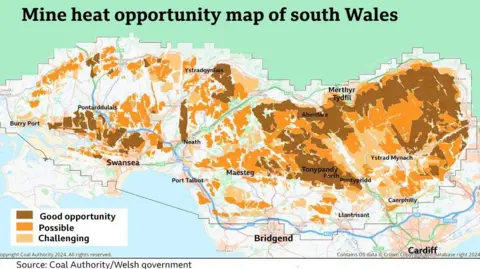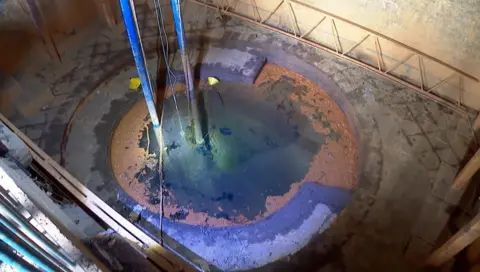 BBC
BBCEnergy bills could be cut by low carbon heat schemes which use water from abandoned Welsh coal mines.
One in five properties in Wales lies above an area which has the potential for a mine water heat scheme, the Coal Authority said.
The temperature of accessible mine water ranges between 10 and 20C depending on the depth.
Work is under way to look at developing mine water heat projects in Rhondda Cynon Taf, Caerphilly and north east Wales.
The Welsh government said it was investing in different types of low carbon heat projects to meet the energy demand of the future.
The Coal Authority estimates about two trillion litres of warm water occupy old mine shafts across the UK.
As a result, it considers mine water to be one of the best options to help with the decarbonisation of heating.
Natural gas remains the primary source for heating but the Welsh government has committed itself to reduce its greenhouse gas emissions to zero by 2050.
Research has been carried by the Coal Authority on old mine workings across 11 local authority areas to asses the potential for mine water heat projects.
 Coal Authority
Coal AuthorityGareth Farr, who leads the Coal Authority’s mine water heat project in Wales, said they hope to replicate the success of the UK’s first large scale mine water heat scheme in Gateshead.
“Since the closure of a lot of the collieries, they’ve filled up with water so these schemes operate by us drilling bore holes down to intercept that water,” he said.
“It’s then brought to the surface and heat exchangers recover heat from the water which is returned safely below ground. The heat we recover is distributed through heat networks to homes, offices or industrial units.
“From mine water heat in the north east of England, it has shown to be delivering heat at 5% below the gas heat price to customers, so that is really important especially during a cost of living crisis.”

Ffynnon Taf primary school in Taff’s Well, Rhondda Cynon Taf, is an example of a small-scale local heat scheme where the village’s natural thermal spring is used to heat the school’s building and a pavilion in the park.
But other community based heat schemes in Wales have not had the same success to date.
A feasibility study for a project in Caerau, Bridgend, was carried out a few years ago in the hope it would benefit homes and a school, but the local authority scrapped the project due to cost. It said it would look at alternative options in the future.
The Coal Authority said it was important to learn from national projects which have succeeded.
 Tyneside Photographic
Tyneside PhotographicScott Morrison, from the Glasshouse International Centre for Music in Gateshead, said it has saved tens of thousands of pounds since it joined the town’s mine water heat scheme in spring 2023.
Five kilometres of pipes supplies homes, businesses and public buildings with heat throughout the year.
“Because we’re a large building, our energy bills are one of our biggest annual costs.
“The other benefit is we’re also aiming to be net zero by 2030 so we’re trying to make a serious response to the climate crisis and this really helps us reach that target,” Mr Morrison said.
 Coal Authority
Coal AuthorityIn a statement Ken Skates, Cabinet Secretary for Economy, Transport and North Wales, said: “With heating accounting for 50% of energy use in the Wales, mine water heat could improve the sustainability of the places where we live and work.
“Mine water heat could also play a part in our necessary efforts to tackle climate change and support decarbonisation.
“By looking at projects such as mine water heating, as well continuing to make strides in the delivery of a swathe of other renewable energy schemes, there is every reason to be optimistic about our future as global leaders both in the adoption and creation of cleaner energy and the technology that facilitates it.”

